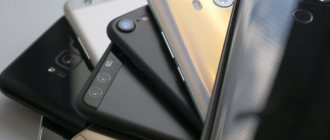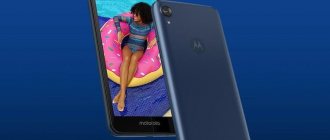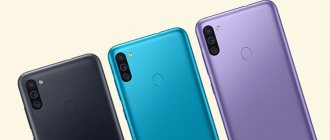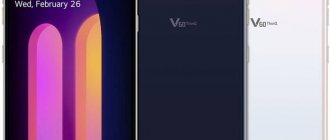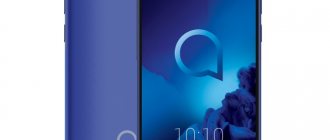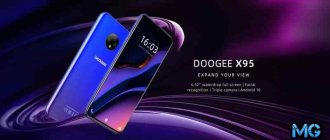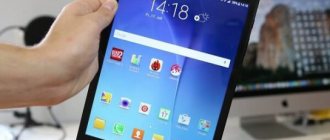Last year's situation with the smartphone market has not changed and, perhaps, has even worsened: in the relatively middle segment (from 25 to 50 thousand rubles) it is not so easy to find something that is not exactly good - no, there are enough normal phones - but rather stands out from the general background . The unification is impressive. At the same time, the ultra-budget segment has thinned out somewhat. But in the segment up to 20 thousand rubles, the choice is extensive, varied and not always obvious. We are trying to figure it out.
realme 8
- Operating system: Android 11 (realme UI proprietary shell).
- Display: 6.4 inches, AMOLED, 2400 × 1080.
- Platform: Mediatek Helio G95 (2 × ARM Cortex-A76, 2.05 GHz and 6 × ARM Cortex-A55 Silver, 2.0 GHz).
- RAM: 4/6/8 GB.
- Flash memory: 64/128 GB.
- Camera: 64+8+2+2 MP.
- Two SIM cards, separate slot for memory card.
- Battery capacity: 5000 mAh.
- Price: 18,490 rubles for the 6/128 GB version.
Why you should buy: AMOLED display, good cameras, interesting design, fast charging, under-screen scanner.
What can stop: mono speaker (compared to Redmi Note 10S).
The realme brand continues its offensive in the budget segment - however, this year there was no such bomb as realme 6 Pro, but realme 8 also looks very cool: a combination of an AMOLED screen, 128 GB of memory, a fairly powerful processor, a capacious battery, 30 W charging and prices of 18.5 thousand rubles are almost unique.
The Redmi Note 10S, which you will see next door, also offers stereo speakers and claimed splash protection, but, on the other hand, at the same price, it has less memory and is saddened by typical Redmi advertising in the shell. It’s also worth saying that realme 8, with very similar characteristics, is also a little lighter and thinner. I also considered the scanner under the screen to be an advantage - but here, of course, it’s a matter of taste. Of course, the capacitive sensor in the side key, like most competitors, is more sensitive, but due to the small area, I always have big problems with them (which, as a rule, do not exist with screen scanners).
Alternative: realme NARZO 30 . In general, realme follows on the heels of Xiaomi in almost everything - it even created its own sub-brand for “gaming” smartphones. NARZO 30 is very close in features and values to POCO M3 Pro: MediaTek Dimesity 700, 90Hz LCD screen, simplified cameras. But it just doesn’t have enough RAM - 4 GB versus 6 GB for its direct competitor Xiaomi. And so - a very worthy option in its genre.
⇡#Xiaomi Redmi Note 10S
- Operating system: Android 11 (MIUI proprietary shell).
- Display: 6.43 inches, AMOLED, 2400 × 1080.
- Platform: Mediatek Helio G95 (2 × ARM Cortex-A76, 2.05 GHz and 6 × ARM Cortex-A55 Silver, 2.0 GHz).
- RAM: 6/8 GB.
- Flash memory: 64/128 GB.
- Camera: 64+8+2+2 MP.
- Two SIM cards, separate slot for memory card.
- Battery capacity: 5000 mAh.
- Price: 18,990 rubles for the 6/64 GB version, 19,580 rubles for the 6/128 GB version.
Why you should buy: AMOLED display, good cameras, stereo speakers, splash protection, fast charging.
What can stop: advertising in the shell, slightly more expensive than the almost identical realme 8.
Xiaomi, it would seem, did everything right - a normal, but not the most powerful hardware platform, an AMOLED screen, a dedicated slot for a memory card, enough RAM, even the design is nice again, and the previous mistakes are no longer repeated (NFC is in place). But the BBK concern with its discount brand realme is again very serious - and has released a smartphone with almost identical characteristics, but a little cheaper and a little better, and even without advertising in the interface.
So the choice of the Redmi Note 10S - with all the unconditional logic of this step - can only be dictated by commitment to the brand, love for MIUI (despite the advertising in the shell, it is still superior to realme UI) and stereo speakers, and of course very private design preferences.
Alternative: Xiaomi Redmi Note 9S. Larger, simpler in filling (LCD display), with slightly simpler cameras, and just last year’s version. But with the Qualcomm Snapdragon 720 platform, those who don’t like MediaTek will like it. And with a larger screen - 6.43 inches, like on the Redmi Note 10S, may not be enough for some.
Xiaomi Redmi 9C
- Screen 6.53″, resolution 1600×720 pixels.
- Camera 13+2 MP, autofocus
- Memory 3/64 GB, memory card slot
- Processor MediaTek Helio G35
- Battery 5000 mAh
The top best budget smartphones cannot be imagined without the Xiaomi model. One of the most inexpensive but good gadgets from the manufacturer is Redmi 9C with NFC support, a huge screen and a 5000 mAh battery. It can be found in blue, red and black colors at a price of 9,900 rubles.
The MediaTek processor, typical for devices in the budget price category, of course, does not turn a smartphone into a gaming one, but it copes quite quickly with launching instant messengers, surfing and other standard applications. The gadget will even run many 3D games, albeit at minimum settings. The only drawback of the model is slow charging via microUSB.
If you are willing to pay a couple thousand extra, pay attention to the Redmi 9 model - it costs a little more, but is equipped with a quad camera and a more powerful processor, and uses USB-C for charging.
⇡#Xiaomi POCO M3 Pro
- Operating system: Android 11 (MIUI proprietary shell).
- Display: 6.5 inches, IPS, 2400 × 1080, 90 Hz.
- Platform: MediaTek Dimesity 700 5G (2 × ARM Cortex-A76, 2.2 GHz frequency and 6 × ARM Cortex-A55 Silver, 2.0 GHz frequency).
- RAM: 4/6 GB.
- Flash memory: 64/128 GB.
- Camera: 48+2+2 MP.
- Two SIM cards, separate slot for memory card.
- Battery capacity: 5000 mAh.
- Price: 17,990 rubles for the 6/128 GB version.
Why you should buy: powerful hardware platform, 90 Hz screen, good battery life, bright design.
What can stop you: a regular camera, an LCD screen, heavy for its size.
Perhaps the main gaming smartphone in the selection is, quite naturally, POCO. True, it will not give a giant lead over its colleagues on the Snapdragon 720G or MediaTek Helio G95 - in terms of power, the advantage here is only in the clock frequency of the productive cores. But thanks to the 7nm process technology, the situation with power consumption is better, that is, with the same battery as, for example, on the Redmi Note 10S, the POCO M3 Pro will last longer. In addition, there is a screen with support for a higher refresh rate (90 Hz).
The POCO M3 Pro does not have any serious “side effects” - it’s just that the conventionally “gaming” gadget has slightly sacrificed cameras, it is also very heavy and lacks an OLED screen (otherwise the price would have ballooned). But there is no advertising in the shell, like Redmi. It’s also worth mentioning here about POCO X3 Pro, which, in a number of parameters, seems to be an ideal choice in the field of inexpensive smartphones for gamers, but in reliable stores it still costs a little more than 20 thousand. However, if you look for discounts, you can get by.
Alternative: Xiaomi POCO M3. Without the word PRO in the name, this is a budget “gaming” smartphone. Very conditionally gaming - with a Qualcomm Snapdragon 662 and a 60 Hz screen. But it’s cheaper, more compact, extremely autonomous and just as bright as Pro. Well, this is perhaps the best choice if you are looking for a smartphone that fits into the lower price bracket in our range.
Nokia G10 3/32GB
Not a bad offer from Nokia. G10 is part of the company's new line.
A 6.5-inch matrix with a resolution of 1600×720 pixels is installed. The camera is triple. It takes good pictures, especially during the day. What's great is that this model has a scanner, and it is combined with a power button. But NFC is missing.
The chip used is MediaTek Helio G25. The processor is not the most powerful, but let's not forget that the Nokia G10 uses an almost stock version of Android, which is characterized by high speed.
According to Nokia tradition, there is a separate key on the side to call the Google voice assistant.
- Screen diagonal: 6.5 inches
- Screen resolution: 1600×720
- Weight: 194 g
- Number of SIM cards: 2
- Processor: MediaTek Helio G25
- Memory capacity: 32 GB
- RAM capacity: 3 GB
- Battery capacity: 5050 mAh
- Rear camera: three 13/2/2 MP modules
- Front camera: 8 MP
- Memory card support: yes
⇡#Samsung Galaxy A32
- Operating system: Android 11 (native shell).
- Display: 6.4 inches, Super AMOLED, 2340 × 1080, 90 Hz.
- Platform: MediaTek Helio G80 (2 × ARM Cortex-A75 2.0 GHz and 6 × ARM Cortex-A55 1.8 GHz).
- RAM: 4/6/8 GB.
- Flash memory: 64/128 GB.
- Camera: 64+8+5+5 MP.
- Two SIM cards, separate slot for memory card.
- Battery capacity: 5000 mAh.
- Price: 18,400 rubles for the 4/128 GB version.
Why it’s worth buying: good battery life, AMOLED screen with 90 Hz, good camera, under-screen scanner.
What can stop it: a cutout, a tendency to overheat, not the most powerful hardware platform, no fast charging, not enough RAM.
Another good budget smartphone from Samsung - this trend is even alarming: the Koreans have actually been making relatively decent inexpensive handsets for many years now. The Galaxy A32 is even unique in some ways - at least no one else has the combination of an AMOLED panel and 90 Hz. In addition, we note the successful, non-slip plastic case and the absence of any outright mistakes - everything important is in place.
But, of course, the Galaxy A32 does not stand out in terms of power - after all, Samsung has saved, is saving and will continue to save on hardware platforms. Again, I note MediaTek’s expansion not only into the ultra-budget segment, but also higher: there are much fewer Snapdragons here than before, and Samsung has begun to use its own chips less often. Curious.
Alternative : Samsung Galaxy A22. Unfortunately, the state of the Russian currency does not allow the technology to at least maintain its price from year to year - and the M-series is no longer among those available at a price below 20 thousand rubles, even if we are talking about last year’s Galaxy M31, which was included in the same selection for 2020. So, in fact, there are no real alternatives to the A32 - except that you can save an extra 2-3 thousand by buying a younger brother that is simpler in all respects, the A22.
Samsung Galaxy A11
- Screen 6.4″, resolution 1560×720 pixels.
- Camera 13+2+5 MP
- Memory 2/32 GB, memory card slot
- Qualcomm Snapdragon 450 processor
- Battery 4000 mAh
Decent budget smartphones can be found from the Korean manufacturer Samsung - these are the younger models in the Galaxy A and Galaxy M lines. One of the most affordable is the Galaxy A11, which was released in 2020. On Yandex.Market, a gadget with a 32 GB drive can be purchased from 9,500 rubles.
The characteristics of the smartphone are quite modest, but what is surprising is the support for contactless payments and memory cards up to 512 GB. The smartphone also runs on the latest Android 10 and is equipped with a 4000 mAh battery - and it is charged via modern USB-C, not microUSB. The main camera has three sensors - it is high enough to take a quick photo for social networks or photograph an important document.
The smartphone comes in three colors, including not only classic black, but also red and white. The body of the device is made of plastic, as is the case with inexpensive models.
⇡#Infinix Note 10 Pro
- Operating system: Android 11 (XOS proprietary shell).
- Display: 6.95 inches, IPS, 2460 × 1080.
- Platform: Mediatek Helio G95 (2 × ARM Cortex-A76, 2.05 GHz and 6 × ARM Cortex-A55 Silver, 2.0 GHz).
- RAM: 6/8 GB.
- Flash memory: 54/128/256 GB.
- Camera: 64+8+2+2 MP.
- Dual SIM cards, dedicated memory card slot.
- Battery capacity: 5000 mAh.
- Price: 18,840 rubles.
Why it’s worth buying: a huge display with support for a frequency of 90 Hz, a good main camera, fast charging (and battery life acceptable for a giant diagonal), stereo speakers.
What can stop it: controversial shell, dimensions, problems with throttling.
The Infinix brand, new to Russia, entered the market very vigorously - at first there were problems with the availability of basic functions (LTE, NFC bands) with a very appetizing combination of price and characteristics, but just starting with the Note 10 Pro model, everything returned to normal.
This is a smartphone primarily for those who love large diagonals: of course, it is hefty, thick and uncomfortable, but the screen is almost seven inches. Apart from size, nothing much has been sacrificed: a normal platform, fast charging, stereo speakers, even support for 90 Hz - that is, yes, playing on the Infinix Note 10 Pro is pleasant. But you will have to endure the controversial XOS shell (functional, but overloaded and crookedly Russified), and you also need to be prepared for throttling under heavy load. Otherwise, it’s a very decent gadget, if you’re not afraid of little-known brands.
Alternative: Infinix HOT 10S . Another giant, but cheaper. Already 6.82 inches, a less powerful hardware platform, a simple camera, no stereo speakers, but still the same 90 Hz and impressive autonomy (6000 mAh) for 12 thousand rubles.
Redmi 7
- Display: 6.26 inches, IPS, 1560 x 720 pixels
- Dimensions: 58*158.73*8.47 mm
- Weight: 180 g
Price: from 8,600 rub.
A lot has already been said about the Redmi brand, which separated from Xiaomi - these are very interesting devices in their price segments, which are often the main option for purchase.
Redmi 7 came out at the beginning of 2021 and created a buzz. This is the case when almost everything in a smartphone is perfect - a decent Snapdragon 632 processor, 2/16 or 3/32 GB memory with a dedicated slot for expanding permanent storage, a high-quality 12+2 MP dual camera and a decent 8 MP front module. The device has a capacious 4000 mAh battery with fast charging, a high-quality screen with Gorilla Glass 5 protection, and a beautiful design with P2i water-repellent coating. The new product runs on the latest version of Android 9.0. A serious minus is the lack of NFC.
Advantages:
- Excellent display with protective glass.
- Pleasant appearance and moisture-repellent coating.
- Powerful processor.
- Good camera.
- Autonomy – 14 hours of video viewing.
- Fast charging.
- Separate memory slot.
Flaws:
- No NFC.
- Old MicroUSB connector.
⇡#OnePlus Nord N10 5G
- Operating system: Android 10 (proprietary shell).
- Display: 6.49 inches, IPS, 2400 × 1080 pixels, 90 Hz.
- Platform: Qualcomm Snapdragon 690 (2 × Kryo 560 Gold, 2.0 GHz frequency and 6 × Kryo 560 Silver, 1.7 GHz frequency).
- RAM: 6 GB.
- Flash memory: 128 GB.
- Camera: 64+8+2+2 MP.
- Dual SIM cards, hybrid memory card slot.
- Battery capacity: 4300 mAh.
- Price: 19,990 rubles.
Why you should buy: 90 Hz display, rear-panel scanner, good hardware platform, good ergonomics, excellent battery life and fast charging, almost pure Android.
What can stop it: no official supplies, usually more than 20 thousand, the display is so-so (except for 90 Hz).
The cheapest OnePlus gets a lot of criticism, but if you can snag it for less than 20 thousand rubles, it can be a very good choice. Yes, there will be no update to Android 12, there is no talk of “killing flagships”, but at its level it looks more than decent - if you don’t mind the boring and even slightly archaic design with a rear fingerprint scanner (which in this case works averagely) , but the location is still the most convenient).
The pluses are a very good hardware platform (although its main feature, of course, is not played out here - there is only talk about 5G in Russia, nothing more), a screen with support for 90 Hz, a fast and unobtrusive shell, excellent battery life.
Alternative: vivo Y31 . Vivo smartphones are again slightly overpriced - the V series no longer falls into the category under 20 thousand rubles, although last year's V20 SE was very good in this range. However, the vivo Y31, which still fits, is quite good: excellent design, large and well-tuned screen, dedicated (and not hybrid, like the OnePlus N10) memory card slot - although overall nothing outstanding, of course. A normal moderate choice - worth paying attention in case of some interesting promotions, 15 thousand is a good option.
Realme C2
- Display: 6.1 inches, IPS, 1560 x 720 pixels
- Dimensions: 7*154.3*8.5 mm
- Weight: 166 g
Price: from 6,990 rub.
The Chinese brand Realme appeared only in 2021, but has already managed to attract the attention of the whole world with its interesting and inexpensive smartphones. The company positions its products as devices for young people - stylish, affordable and with modern functions.
C2 is a device with an original design, where they did not repeat the already secondary, albeit spectacular, iridescent covers, but made a surface with a geometric pattern. The large display does not have the highest resolution, but this is aimed at improving autonomy and does not cause any particular inconvenience. As a tribute to fashion, the screen received a drop-shaped cutout for a 5 MP camera, which has a face unlock function. There is no fingerprint scanner provided. The rear camera is dual – 13+2 megapixels, and works quite well for its price tag. Battery 4000 mAh. Taking into account the low screen resolution and energy-intensive processor, Helio P22 demonstrates excellent battery life.
The memory of the new product is presented in two modifications - 2/16 or 3/32 GB. Pleasantly pleased is the dedicated slot for microSD with a capacity of 256 GB. The device runs on the latest Android 9.0 OS.
Advantages:
- Good autonomy.
- Interesting design.
- High-speed face unlock.
- Dedicated memory slot.
- Fresh OS.
Flaws:
- Quite an old processor.
- No finger scanner.
⇡#Moto G9 Plus
- Operating system: Android 10.
- Display: 6.81 inches, IPS, 2400 × 1080 pixels.
- Platform: Qualcomm Snapdragon 730G (2 × Kryo 470 Gold, 2.2 GHz frequency and 6 × Kryo 470 Silver, 1.8 GHz frequency).
- RAM: 4 GB.
- Flash memory: 128 GB.
- Camera: 64+8+2+2 MP.
- Dual SIM cards, hybrid memory card slot.
- Battery capacity: 5000 mAh.
- Price: 19,690 rubles.
Why it’s worth buying: large display, pure Android, powerful Qualcomm platform, good main camera, normal battery life + fast charging.
What can stop it: impressive dimensions, lack of RAM, secondary cameras do not shine.
One of the points from last year’s selection does not change in 2021. Motorola did not prepare an adequate replacement for the G9 Plus in a year, but it did not really become obsolete - but it managed to become more expensive. A year ago you could buy it for 17 thousand, and now - for almost 20. Such things.
Otherwise, it's still a good choice. The platform is still relevant - there are really no more powerful smartphones in this selection, there are only comparable ones. The screen is large (though not extreme, the Infinix Note 10 Pro is responsible for this), the main camera is good, there is fast charging, and Android is still the same clean, without impurities. Unless the amount of RAM is seriously starting to confuse. And so it’s a very worthy device, and not only for fans of the brand.
Alternative: M oto G9 Play . If you really want Motorola, but have less money, everything is simple.
Looking for a budget smartphone
It was not easy for us to create this rating, because there are not so many worthy smartphones in the range of up to 7,000 rubles. Many may disagree with us. In mobile phone stores and electronics hypermarkets there are indeed a large number of smartphones in the range from 2,500 to 5,000 rubles. But after studying their characteristics, owner reviews and expert reviews, we cannot recommend them for purchase. Such a smartphone will bring you nothing but wasted money and nerves.
What to expect in a budget smartphone in 2021
- Year of release 2017-2018
- Battery not less than 3000 mAh
- Screen resolution of at least 1280×720
- Screen diagonal from 5 inches
- RAM from 2 GB
- Internal memory from 16 GB
- Minimum cost 5500 rubles
⇡#TCL 10L
- Operating system: Android 10 (own TCL UI shell).
- Display: 6.53 inches, IPS, 2400 × 1080.
- Platform: Qualcomm Snapdragon 665 (4 × Kryo 260 Gold, 2.0 GHz frequency + 4 × Kryo 260 Silver, 1.8 GHz frequency).
- RAM: 6 GB.
- Flash memory: 64/128/256 GB.
- Camera: 48+8+2+2 MP.
- Dual SIM cards, hybrid memory card slot.
- Battery capacity: 4000 mAh.
- Price: 18,990 rubles for the 6/256 GB version.
Why you should buy: a lot of memory, Qualcomm platform, fingerprint scanner on the rear panel.
What can stop it: average performance, hybrid memory card slot, no fast charging.
The mysterious history of the TCL L series - last year's smartphone looks more interesting in almost all respects than the new one, and even cheaper. It has a more powerful hardware platform (albeit not powerful enough in general), more memory, it is more interesting in appearance, more compact, and more convenient. Where the new TCL 20L is superior to the TCL 10L is only in autonomy and screen size. The latter, however, cannot always be considered an advantage.
If we compare the TCL 10L not with its family brother, but with all the others, then there are quite a few advantages. One thing is certain - this is a quarter-terabyte drive. A combined slot for MicroSD and SIM card in this case no longer seems such a sin. Otherwise, it’s a completely ordinary smartphone for its price category. But you can be original with an unusual brand.
Alternative: TCL 20L . Actually, the successor to the TCL 10L - the pros and cons are listed above.
OPPO A15s
This is a slightly different version of the OPPO A15, which was in good demand. What's new?
We managed to find out that the changes are the bare minimum: mainly an increased amount of memory. So, if the OPPO A15 used 2 GB of RAM and 32 GB of main memory, here these numbers increased to 4 GB and 64 GB, respectively. Great, you agree. The resolution of the front camera was also increased - up to 8 MP.
The smartphone still has a good 6.52-inch screen, an 8-core MediaTek Helio P35 (MT6765) chip, a decent battery life is provided by a 4230 mAh battery, and the scanner is located on the back cover. The predecessor didn’t have NFC, and it doesn’t exist here either.
- Screen diagonal: 6.52 inches
- Screen resolution: 1600×720
- Weight: 177 g
- Number of SIM cards: 2
- Processor: MediaTek Helio P35 (MT6765)
- Memory capacity: 64 GB
- RAM capacity: 4 GB
- Battery capacity: 4230 mAh
- Rear camera: triple 13/2/2 MP
- Front camera: 8 MP
- Memory card support: yes
⇡#TECNO POVA 2
- Operating system: Android 11 (proprietary HiOS shell).
- Display: 6.9 inches, IPS, 2460 × 1080.
- Platform: Mediatek Helio G85 (2 × Cortex-A75, 2.0 GHz frequency + 6 × Cortex-A55, 1.8 GHz frequency).
- RAM: 4 GB.
- Flash memory: 64/128 GB.
- Camera: 48+2+2+2 MP.
- Two SIM cards, separate slot for memory card.
- Battery capacity: 7000 mAh
- Price: 13,600 rubles for the 4/64 GB version, 14,600 rubles for the 4/128 GB version.
Why you should buy: Huge display, huge battery.
What can stop it: gigantic dimensions, controversial shell, not enough RAM, so-so performance, one available focal length.
A very highly specialized smartphone - for lovers of both huge and very autonomous devices. TECNO turns both knobs to the maximum, and does not limit the display resolution, as is often the case with gadgets that focus on the battery.
Everything else is more or less based on the residual principle, but a relatively decent level is maintained: there is a camera with a Quad Bayer sensor, a separate slot for a memory card, and a nice design. But there are also plenty of shortcomings - compromises are inevitable with such a specialized gadget.
Alternative: Lenovo K12 Pro . The first smartphone of the Lenovo brand, which has returned to the Russian smartphone market, also offers a large display, but with HD resolution, which allows it to maintain approximately the same level of autonomy with a smaller battery. Also a plus is pure Android, and a generally calmer performance.
Which budget smartphone with a good camera to choose?
When choosing a smartphone with a good camera, you need to pay attention to its parameters. You won’t be able to get a high-quality photo with a single or even dual camera. The number of sensors should be 3 or 4. It is desirable that one of the modules be wide-angle.
- A telephoto lens will help you capture objects located at a great distance. The number of pixels and their size matters. The larger it is, the better the pictures will be.
- Some smartphones use binning technology, in which several dots are combined into one large one. The size of the matrix has a positive effect on photo quality, but 100 megapixels and more are found in expensive smartphones.
- Good photos in the dark or low light are obtained with an aperture of f/1.8 or lower.
- It is desirable that the phone has autofocus, a telemodule with optical zoom, and a portrait depth sensor (available in most of these models).
- The camera resolution must be at least Full HD.
- It is better to take the front camera with a resolution of 15 megapixels or more.
⇡#Honor 10X Lite
- Operating system: Android 10 with Magic UI shell and without Google services.
- Display: 6.67 inches, IPS, 2400 × 1080.
- Platform: HiSilicon Kirin 710A (4 × ARM Cortex A73, 2.0 GHz frequency + 4 × ARM Cortex A53, 1.7 GHz frequency).
- RAM: 4 GB.
- Flash memory: 128 GB.
- Camera: 48+8+2+2 MP.
- Two SIM cards, separate slot for memory card.
- Battery capacity: 5000 mAh.
- Price: 17,200 rubles.
Why it’s worth buying: large and well-tuned screen, good quality of shooting with the main camera.
What can stop you: mediocre performance, very slippery body, no Google services.
Released in December last year, Honor 10X Lite was supposed to be the brand's last smartphone without Google services, but... after more than nine months, it is still the last smartphone of the brand as a whole - without any services. It seems that Honor has fought off all sorts of sanctions, but things are still the same - no new models are coming to the market.
The smartphone itself is notable primarily for its relic status, pleasant design and successful display (for lovers of LCD panels), but I would like to recommend it only to fans of the brand, because neither in terms of performance nor in terms of software capabilities (without Google services) it is comparable to its competitors falls short. Although I’ll also note the quality of shooting with the main camera - here Huawei/Honor traditionally stand out, even if the sensor itself is ordinary.
Alternative: Huawei P Smart 2021 / Honor 30i . For Huawei lovers, we can recommend the Huawei P Smart 2021, which is extremely close to the 10X Lite in terms of characteristics, and for lovers of OLED displays, we can recommend the Honor 30i, which is controversial in other aspects.

